Key takeaways:
- Understand your own value and time investment in creating art to set appropriate prices.
- Research audience preferences and current market trends to effectively price artwork.
- Engage with fellow artists and collectors for insights on pricing strategies and market value.
- Communicate pricing with clarity and a personal narrative to enhance buyer perception.
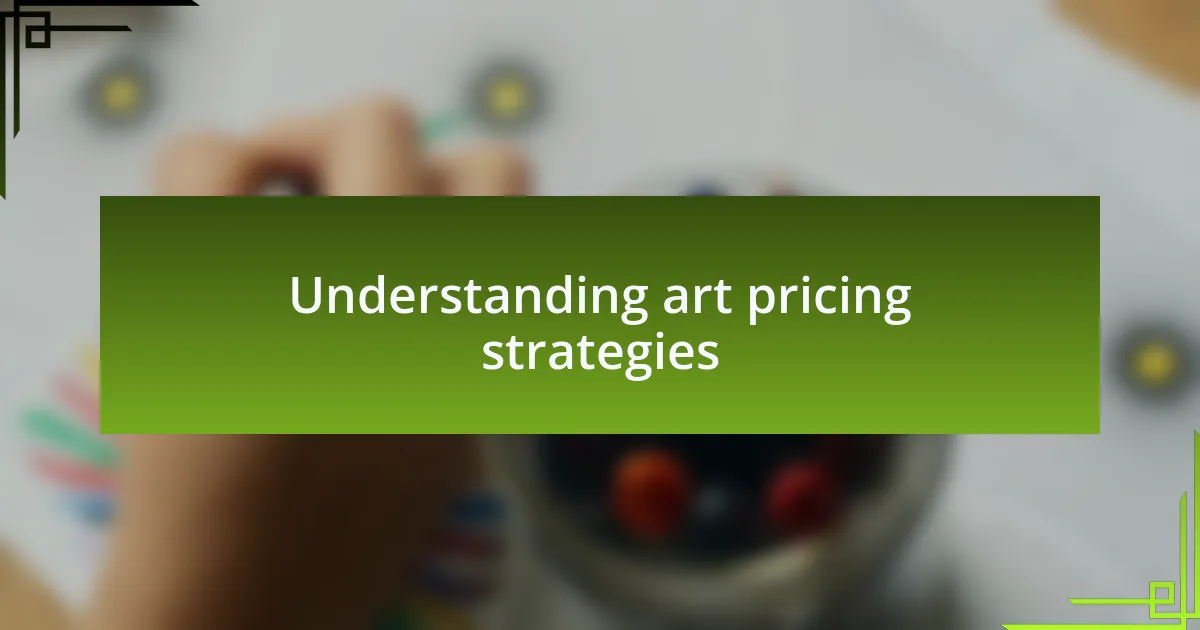
Understanding art pricing strategies
When considering art pricing strategies, it’s essential to reflect on the value of your time and effort. I remember when I first started selling my artwork; I undervalued myself significantly. The moment I realized that my creativity and labor deserved to be compensated fairly was transformative. How often do we shortchange our own passions simply because we feel uncertain about their worth?
Another critical aspect of pricing art revolves around understanding your audience. I once crafted a series of pieces that resonated deeply with a local community, and I priced them based on that emotional connection. It was rewarding to see how people were willing to pay a premium for art that spoke to their experiences. Have you ever noticed how some artworks spark a personal connection? That emotional pull can justify a higher price point.
Then there’s the competitive landscape to consider. When I first ventured into selling, I examined similar artists’ works to gauge pricing, which helped me find the right balance. I encourage artists to research their peers; it’s a valuable way to identify where you stand and how to effectively position your art. Have you ever found yourself lost in a sea of prices, unsure of where you fit? Trust me, this exploration not only enhances your confidence but also shapes how you present your work to potential buyers.
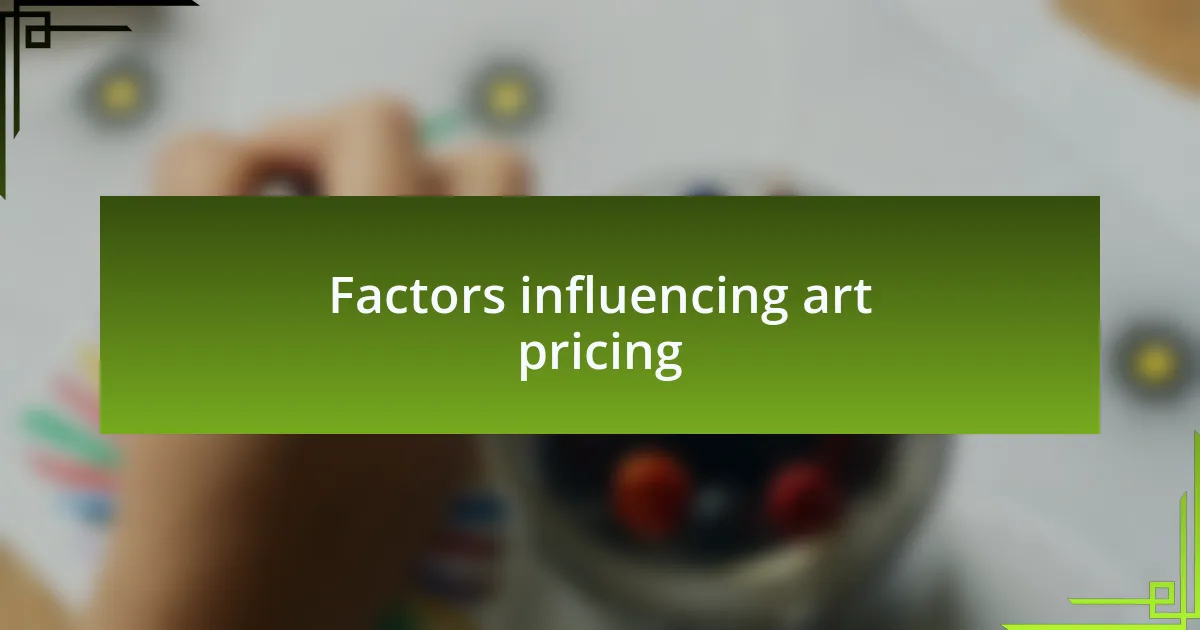
Factors influencing art pricing
Art pricing is influenced significantly by the materials used and the time invested in creating a piece. I recall a time when I opted for high-quality paint and canvas for a painting that I ended up spending weeks on. When I sat down to calculate my costs, I realized how those choices not only elevated the final artwork but also justified a higher asking price. Have you ever thought about how the materials you choose can fundamentally alter the perceived value of your art?
Another factor is the artist’s experience and reputation. In my early days, I would often struggle to set prices because I was still building my credibility. However, once I participated in local exhibitions and received positive feedback, I noticed that potential buyers were more inclined to consider me a valuable artist. It made me wonder: how much does the perception of your skill play into how others value your work?
Lastly, external elements such as market trends and seasonal demand also come into play. I remember a particular winter when I created a series of holiday-themed pieces. As the season approached, I noticed an increase in demand, which allowed me to adjust my pricing strategy accordingly. This taught me that being attuned to the market environment can significantly enhance your sales strategy. Have you ever adjusted your pricing based on current trends? It can be a game-changer.
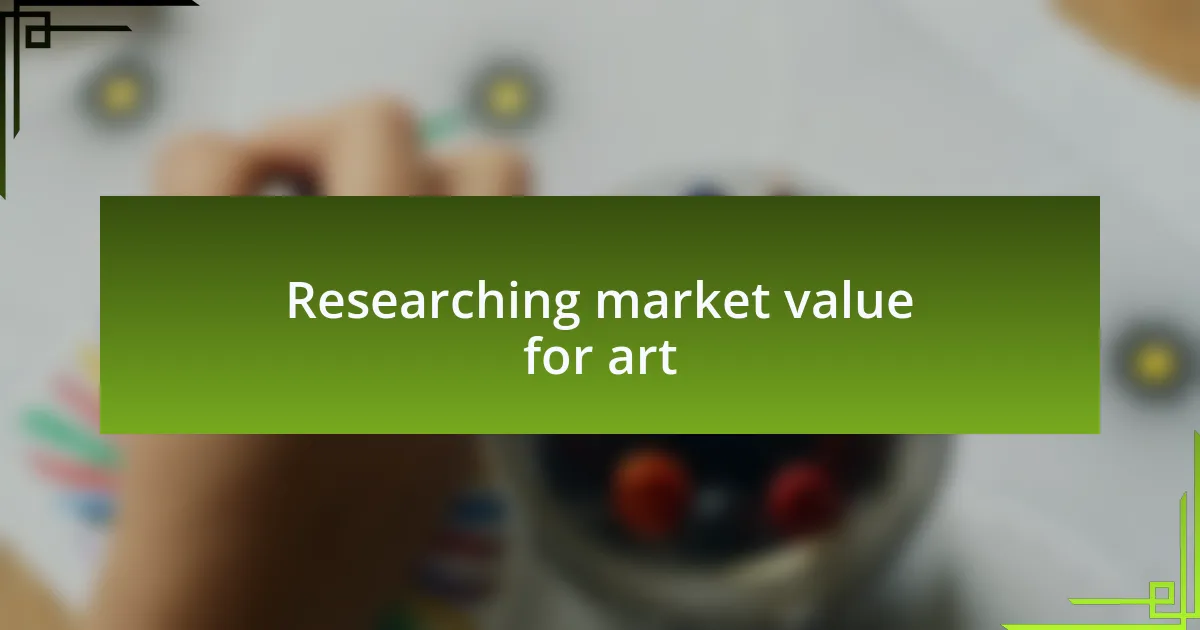
Researching market value for art
Researching market value for art is a crucial step in setting a price that resonates with potential buyers. I remember my first experience attending a local art fair where I eagerly observed how similar pieces were priced. It was eye-opening to realize that an artist’s style and presentation could dramatically influence their market value. Ever found yourself surprised by the pricing differences for similar artwork?
When diving into this research, I often recommend analyzing online platforms where art is sold. Platforms like Etsy or Saatchi Art not only showcase diverse artworks but also provide insights into pricing trends. I once spent an afternoon scrolling through these sites, making notes on what caught my eye and what seemed to fly off the virtual shelves. This experience highlighted how art can be valued differently based on its context, leaving me curious about how you might approach finding that sweet spot for your own creations.
Additionally, engaging with fellow artists and collectors can offer invaluable perspectives. At one point, I joined a community forum where both emerging and established artists shared their own pricing strategies. The candid discussions revealed unique insights into how market value could fluctuate based on demand and audience perception. Have you ever sought advice from peers? Their stories might just give you that extra bit of clarity you need on pricing your art effectively.
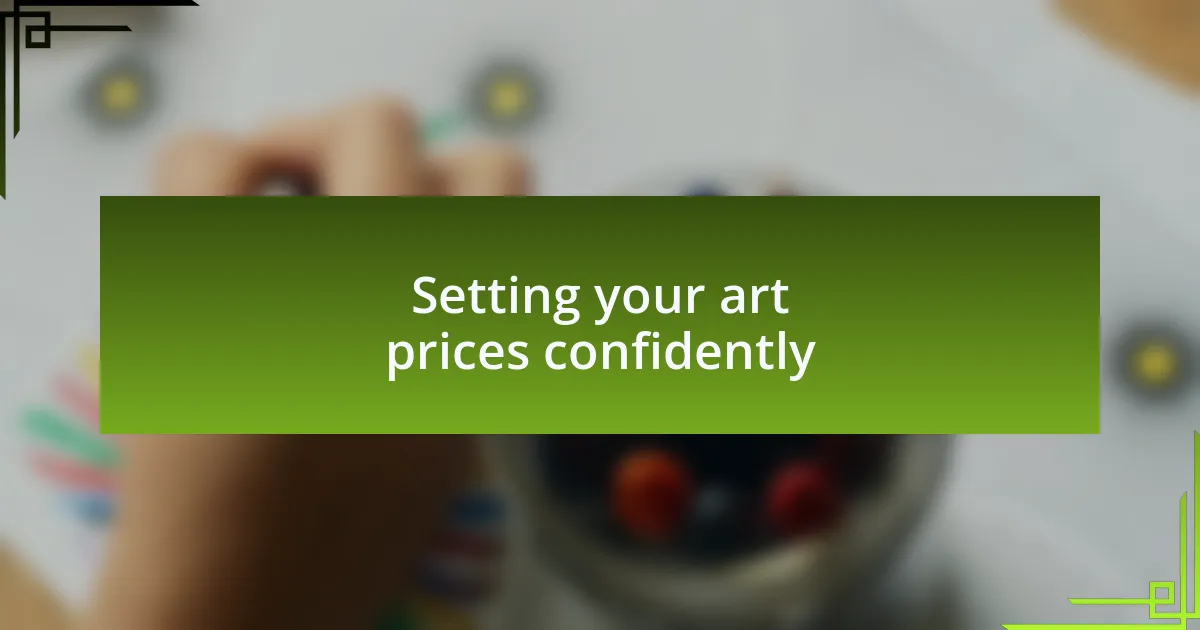
Setting your art prices confidently
When it comes to setting your art prices confidently, understanding your unique value is essential. I recall a moment when I hesitated before pricing a complex piece I had poured my heart into. It dawned on me that my emotional investment and the hours spent refining the details weren’t just labor; they were integral to the artwork’s worth. Have you ever doubted the significance of your creative process? Embracing that personal connection can empower you to price your work more assertively.
Another strategy I’ve found helpful is to consider your target audience. During one exhibit, I observed potential buyers interacting with my work and noticed their enthusiasm for certain themes. This experience taught me that knowing who appreciates your art can guide your pricing decisions. It’s a bit like tailoring a conversation based on the interests of who’s listening. Have you taken the time to think about who your ideal buyers are? That awareness can lead to more confident pricing.
Lastly, don’t shy away from experimenting with your pricing structure. I remember trying out different price points for my pieces during a gallery show and observing how viewers reacted. Some were drawn to higher-priced items, thinking they represented greater quality. This experimentation gave me valuable feedback and taught me that confidence in pricing can evolve over time. What about you? Have you ever adjusted your prices based on feedback or sales? Embracing that flexibility might just help you find the balance that feels right for your artistry.
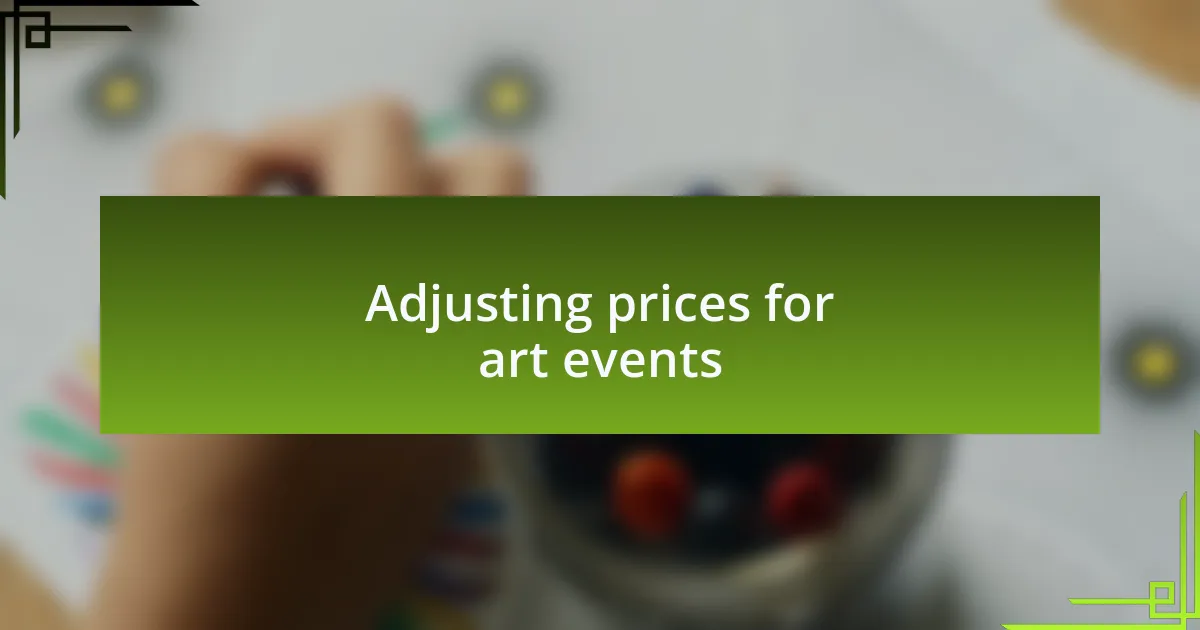
Adjusting prices for art events
Adjusting prices for art events requires a keen understanding of both the market and your own evolving artistry. I remember a local fair where I initially priced my pieces too low, only to realize that my work was undervalued compared to similar artists. After seeing other vendors’ success, I felt a shift in my confidence, prompting me to raise my prices. Have you ever felt that uncertainty about what the market will bear? Understanding local pricing trends can significantly guide your decisions.
Another important consideration is the timing and context of your event. I once participated in a holiday market where I adjusted my prices upward, fully aware that shoppers were looking for unique gifts. This strategic change not only honored the occasion but also resonated with buyers seeking quality art over ordinary gifts. How often do you evaluate the timing of your events when considering your pricing? Recognizing seasonal trends can aid in optimizing your sales.
Finally, don’t overlook the power of feedback from your audience during art events. I’ve had instances where a group of attendees expressed interest in a particular piece only to hesitate when I revealed the price. This taught me a valuable lesson about aligning my price points with audience perception. Have you ever used customer reactions to rethink your pricing strategy? Engaging with your audience in real-time can lead to impactful adjustments that boost both sales and satisfaction.
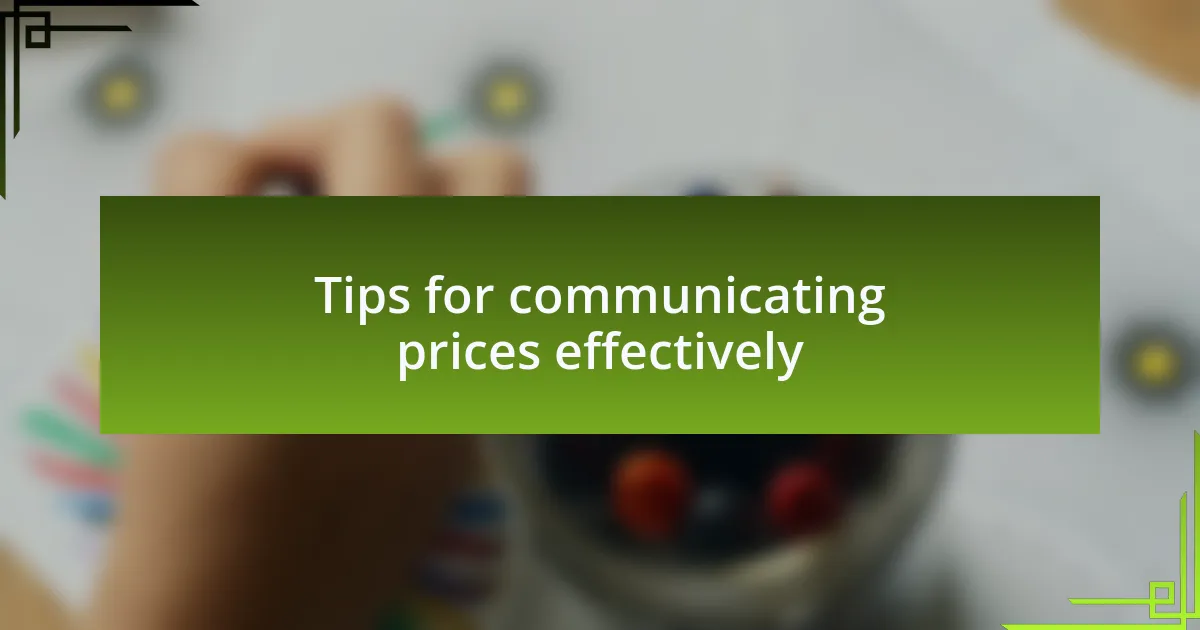
Tips for communicating prices effectively
When it comes to communicating prices, clarity is key. I once participated in an exhibit where I noticed several artists simply listing prices without explanations. So, I made it a point to describe the materials and time invested in my pieces. This not only justified my pricing but also sparked conversations with potential buyers. Have you considered how transparency could enhance your audience’s perception?
Another effective strategy is to create a narrative around your pricing. I remember sharing the story of my inspiration and the creative process behind a specific piece. This personal touch often made attendees more willing to invest in my work. Have you ever thought about how a compelling story can make your art feel more valuable to buyers?
Lastly, don’t underestimate the importance of a friendly demeanor when discussing prices. I learned this at a recent art fair where my approachable attitude helped ease any hesitation buyers felt about pricing. Engaging in light conversation shifted their focus from the price tag to the value of the artwork itself. How do you create an inviting atmosphere for your audience during pricing discussions?